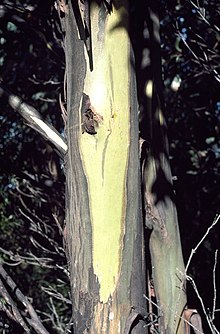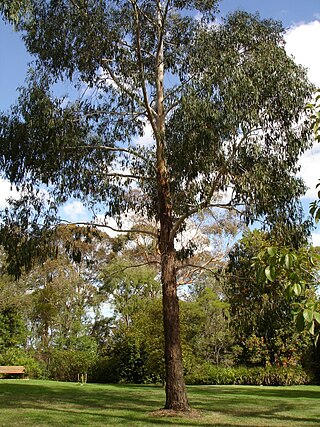
Eucalyptus ovata, commonly known as swamp gum or black gum, is a small to medium-sized tree species that is endemic to south-eastern Australia. It has mostly smooth bark, glossy green, lance-shaped to egg-shaped adult leaves, green flower buds in groups of seven, white flowers and conical to bell-shaped fruit.

Eucalyptus krueseana, commonly known as book-leaf mallee, is a mallee that is endemic to inland Western Australia. It has smooth bark that is shed in ribbons, a crown of sessile, juvenile leaves, glaucous flower buds and greenish yellow flowers.

Eucalyptus nitens, commonly known as shining gum or silvertop, is a species of tall tree native to Victoria and eastern New South Wales. It has smooth greyish bark, sometimes with thin, rough bark near the base, lance-shaped adult leaves, flower buds in groups of seven or nine, white flowers and cup-shaped, barrel-shaped or cylindrical fruit. It grows in wet forests and rainforest margins on fertile soils in cool, high-rainfall areas.
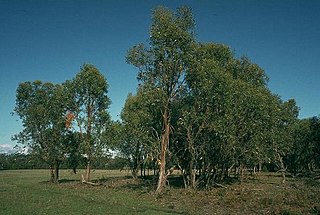
Eucalyptus kitsoniana, commonly known as the Gippsland mallee or bog gum, is a species of small tree or mallee and is endemic to Victoria. It has mostly smooth bark, a crown containing juvenile, intermediate and adult leaves, flower buds in groups of seven, white flowers and sessile, cup-shaped to hemispherical fruit.
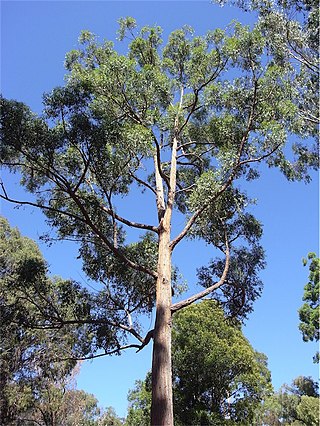
Eucalyptus tindaliae, commonly known as Tindal's stringybark, is a species of tree that is endemic to coastal eastern Australia. It has rough, stringy bark on the trunk and larger branches, lance-shaped to curved adult leaves, flower buds in groups of between nine and fifteen, white flowers and hemispherical fruit.
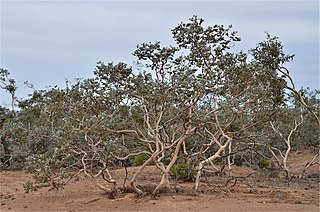
Eucalyptus gillii, known as the curly mallee, Arkaroola mallee, or silver mallee, is a species of mallee or small tree that is endemic to inland Australia. It has smooth bark, sometimes with rough bark near the base, often only juvenile, usually glaucous leaves in the crown, flower buds in groups of between seven and eleven, pale yellow flowers and barrel-shaped or shortened spherical fruit.

Eucalyptus archeri, also known as alpine cider gum, is a mallee or a small tree that is endemic to Tasmania. It has smooth white or greyish bark, lance-shaped adult leaves, flower buds in groups of three, white flowers and conical to barrel-shaped fruit. It intergrades with E. gunnii.

Eucalyptus subcrenulata, commonly known as Tasmanian alpine yellow gum, is a species of small to medium-sized tree that is endemic to the highlands of Tasmania. It has smooth bark, glossy green, lance-shaped to egg-shaped adult leaves, flower buds in groups of three, white flowers and hemispherical to bell-shaped fruit. It is similar to E. johnstonii, E. vernicosa and E. urnigera.

Eucalyptus major, commonly known as grey gum, is a species of tree that is endemic to a small area near the New South Wales - Queensland border. It has smooth greyish bark, lance-shaped adult leaves, flower buds in groups of seven and conical to cup-shaped fruit.

Eucalyptus comitae-vallis, commonly known as Comet Vale mallee or Cowcowing mallee, is a mallee that is endemic to the south-west of Western Australia. It has rough, flaky to ribbony bark on the trunk and larger branches, smooth withish bark above, linear to narrow lance-shaped adult leaves, flower buds in groups of seven to eleven, white flowers and barrel-shaped, conical or cup-shaped fruit.

Eucalyptus herbertiana, commonly known as Kalumburu gum or yellow-barked mallee, is a species of small tree or mallee that is endemic to northern Australia. It has smooth bark, lance-shaped or curved adult leaves, flower buds in groups of seven, white flowers and cup-shaped, hemispherical or conical fruit.

Eucalyptus lesouefii, commonly known as goldfields blackbutt, is a species of mallet or tree that is endemic to central Western Australia. It has rough, black bark on the lower trunk, smooth bark above, lance-shaped adult leaves, flower buds in groups of seven, creamy white flowers and cup-shaped fruit.
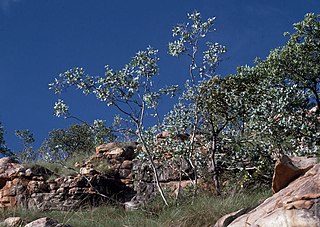
Eucalyptus mooreana, commonly known as Moore's gum, mountain white gum or King Leopold Range mallee, is a species of stunted, straggly tree or mallee that is endemic to the Kimberley region of Western Australia. It has smooth, powdery white bark, a crown of juvenile, sessile, stem-clasping leaves arranged in opposite pairs, flower buds arranged in groups of seven, white flowers and cup-shaped to hemispherical fruit.
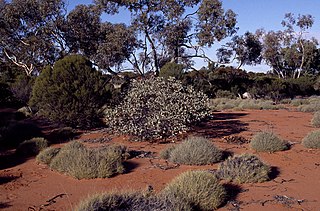
Eucalyptus pimpiniana, commonly known as the pimpin mallee, is a species of shrubby mallee that is endemic to the Great Victoria Desert of South Australia and Western Australia. It has smooth, mottled bark, lance-shaped adult leaves, flower buds in group of between seven and nineteen, yellow flowers and cylindrical to barrel-shaped fruit.

Eucalyptus sessilis, commonly known as Finke River mallee, red bud mallee or river mallee, is a species of mallee that is native to the Northern Territory and central areas along the border of Western Australia. It has smooth bark, sometimes with ribbon of old bark near the base, lance-shaped to egg-shaped or elliptical adult leaves, flower buds in groups of seven, creamy yellow flowers and hemispherical fruit.

Corymbia collina, commonly known as the silver-leaved bloodwood, is a species of tree that is endemic to Western Australia. It has thin patchy rough bark on some or all of the trunk, smooth white to pale grey bark above, lance-shaped to curved adult leaves, flower buds in groups of seven, creamy white flowers and barrel-shaped fruit.

Eucalyptus conglomerata, commonly known as the swamp stringybark, is a species of straggly tree or mallee that is endemic to Queensland. It has rough, fibrous "stringybark" lance-shaped to oblong adult leaves, flower buds in groups of eleven or more, white flowers and more or less barrel-shaped fruit.

Eucalyptus decorticans, commonly known as the gum-top ironbark, is a species of tree that is endemic to Queensland. It has rough, dark grey or black "ironbark" on the trunk and larger branches, smooth white bark on the thinner branches, lance-shaped to curved adult leaves, flower buds in groups of seven, white flowers and conical, cup-shaped or barrel-shaped fruit.

Eucalyptus shirleyi, commonly known as Shirley's silver leafed ironbark, silver-leaved ironbark, or Shirley's silver leaved ironbark, is a species of small ironbark tree that is endemic to Queensland. It has rough ironbark on the trunk and larger branches, the thinnest branches glaucous, a crown composed of sessile, heart-shaped, egg-shaped or round juvenile leaves, flower buds in groups of seven, white flowers and cup-shaped to barrel-shaped fruit.

Eucalyptus clelandiorum, commonly known as Cleland's blackbutt is a species of mallet that is endemic to the South West region of Western Australia. It has hard, black, crumbly bark on the lower half of its trunk, smooth bark above, narrow lance-shaped adult leaves, flower buds arranged in groups of seven, nine or eleven, white flowers and cup-shaped fruit.
